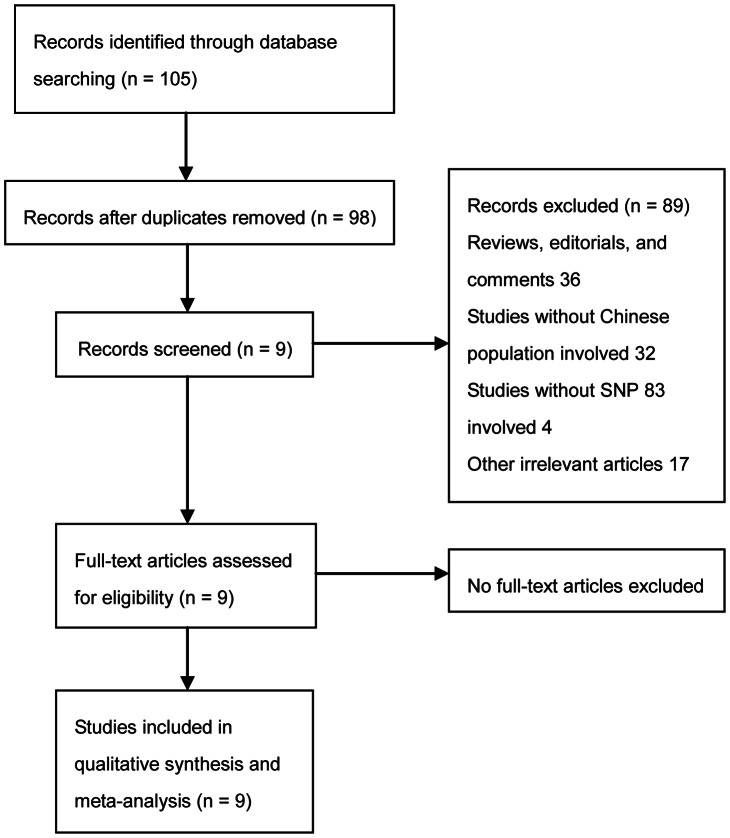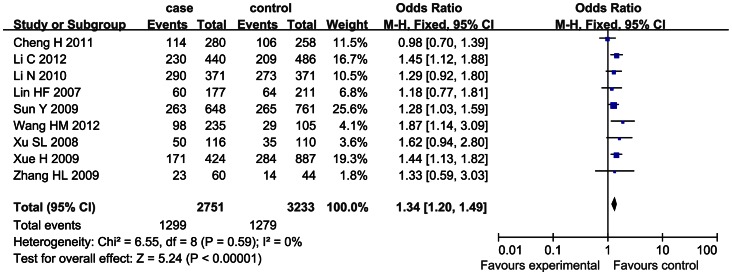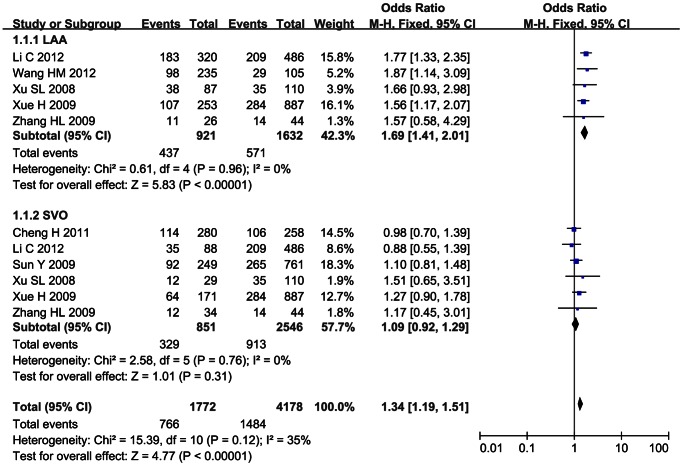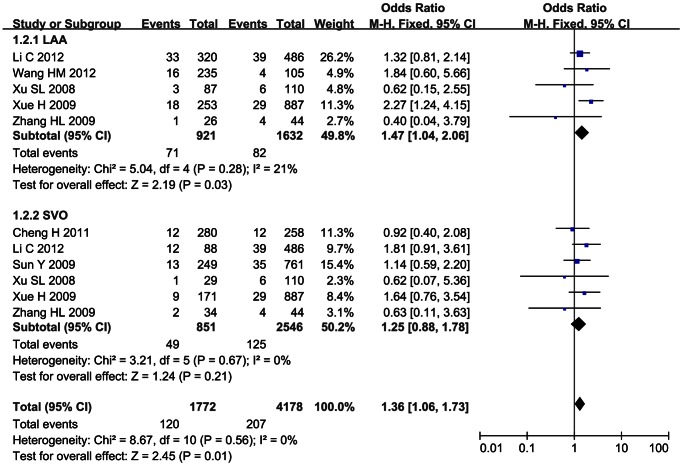Abstract
Background
Stroke is the second most common cause of death and major cause of disability worldwide. The SNP 83 in PDE4D gene has been suggested as a risk factor in ischemic stroke, but direct evidence from genetic association studies remains inconclusive even in Chinese population.
Methods
Meta-analysis of case-control studies on the relationship between SNP 83 in PDE4D gene and susceptibility to ischemic stroke in Chinese population published domestically and abroad from January 2003 to September 2012.
Results
9 case-control studies were selected. Meta-analysis results showed that the significant association between SNP 83 and ischemic stroke was found under the dominant model (OR = 1.34, 95% CI: 1.20–1.49) and recessive model (OR = 1.45, 95% CI: 1.19–1.76) in Chinese population. In subgroup meta-analysis, SNP 83 and atherothrombotic stroke, rather than lacunar stroke, showed the significant association under the dominant model (OR = 1.69, 95% CI: 1.41–2.01) and recessive model (OR = 1.47, 95% CI: 1.04–2.06).
Conclusions
The results suggest that SNP 83 in PDE4D gene is significantly associated with susceptibility to ischemic stroke in Chinese population.
Introduction
Stroke is the second most common cause of death and major cause of disability worldwide. [1] In China, with 1.4 billion populations, the annual stroke mortality rate is approximately 1.6 million, which has exceeded heart disease to become the leading cause of death. In addition, China has 2.5 million new stroke cases each year and 7.5 million stroke survivors. [2] Ischemic stroke is the most type of stroke, and about 43% to 79% of all strokes are ischemic in China. [2]–[3] Traditional factors such as hypertension and smoking account for a significant proportion of ischemic stroke risk, but much risk remains unexplained. [4] Genetic risk factors, suggested by evidence from twin, case-control and cohort studies of familial aggregation, might contribute to a predisposition to ischemic stroke. [5].
The phosphodiesterase 4D (PDE4D) gene is at the locus on chromosome 5q12 and encodes cAMP-specific 30, 50-cyclic phosphodiesterase 4D, belonging to a superfamily of phosphodiesterases (PDE4 family). [6] In 2003, through genome-wide association study (GWAS), Gretarsdottir et al. [7] identify the association of SNP 83 in PDE4D gene with carotid stroke in Icelandic population. Since then, the studies on different populations have been performed to uncover whether SNP 83 in PDE4D gene could participate in ischemic stroke in non-Icelandic populations. However, based on the existing studies, the relationship between SNP 83 in PDE4D gene and ischemic stroke still remains unknown. The association between SNP 83 and ischemic stroke has been found in the population of India, Pakistan and Australia, but this association has not been replicated in the population of Italy, Germany and Japan. [8]–[13]Inconsistency among research findings might be caused by different allele frequencies across study populations, particularly in different ethnic and geographical groups. In order to reduce heterogeneity from these confounding factors, we focus our attention on the association between SNP 83 in PDE4D gene and ischemic stroke in Chinese population.
Even in Chinese population, the conclusions have not reached an agreement. Several studies have reported a positive or null relation between SNP 83 in PDE4D gene and ischemic stroke in Chinese population, but findings have been controversial. [14]–[22] The sample sizes of these studies have been relatively small. To clarify the varying results, we have undertaken this meta-analysis of SNP 83 in PDE4D gene and ischemic stroke in Chinese population.
Materials and Methods
Data Sources
Electronic databases including MEDLINE, CBMdisc(Chinese Biomedical Literature analysis and retrieval system for compact disc), CNKI (China National Knowledge Infrastructure), Chinese VIP database and Chinese WanFang database were searched from January 1, 2003 to September 30, 2012 for all case-control studies evaluating the association of SNP 83 in PDE4D gene with ischemic stroke in Chinese population. The following terms were used in our search strategies: PDE4D/phosphodiesterase 4D and stroke/cerebral infarction/brain infarction/cerebrovascular disease and polymorphism/gene/genotype/variant/allele. The equivalent Chinese terms were used in the Chinese databases. The “related articles” option in MEDLINE, as well as reference lists of all retrieved studies, were checked to search for other relevant articles that were not initially identified. The articles were selected without language restrictions. The entire literature search was performed by two independent researchers.
Study Selection
The studies had to meet the following criteria: (1) The association of SNP 83 in PDE4D gene with ischemic stroke was examined based on case-control design; (2) The population of the studies was restricted to Chinese population. The studies were excluded if one of the following existed: (1) The genotype frequency was not reported, (2) For duplicate publications, the smaller dataset was discarded.
Data Extraction
The two of the authors independently extracted data from each relevant study. Disagreements were reconciled through group discussion.
The following information was collected from each study: (1) first author, journal, year of publication, region, (2) total number, characteristics of cases and controls, subtype of ischemic stroke, distribution of genotypes and alleles in all groups.
Statistical Analysis
Data were analyzed and processed using Review Manager 5.0 and Stata 10.0. Heterogeneity among studies was examined with the I 2 statistic and I 2>50% indicates significant heterogeneity between the studies. Based on the test of heterogeneity, a pooled OR was calculated by using fixed or random effect model, along with the 95% confidence interval (CI) to measure the strength of the genetic association. Publication bias was examined by the visual inspection of funnel plot, Begg’s test and Egger’s regression test (p<0.05 was considered representative of statistically significant publication bias).
Results
Search of Studies and Characteristics of Included Studies
105 studies were identified by the literature search, among which 9 studies met the inclusion criteria. Of the 96 excluded studies, 7 were duplicate publication, 36 were reviews, editorials or comments, 32 were from other ethnic populations, 4 were not involved with SNP 83, 17 were other irrelevant articles. A flow diagram schematized the process of selecting and excluding articles with specific reasons, as shown in Figure 1.
Figure 1. The flow diagram of study selection.
A total of 9 case-control studies of Chinese population were included in the meta-analysis comprising 2751 patients with ischemic stroke and 3233 controls. The ischemic stroke in most studies of our meta-analysis was confirmed by CT or MRI, except one study in which the definition of stroke was not mentioned. [22]The detailed characteristics of the included studies were shown in Table 1. The distributions of genotypes in the individual studies for SNP 83 were shown in Table 2.
Table 1. Characteristics of included studies.
| 1st author, year | Region | Characteristics of the included studies | |
| Ischemic stroke group | Control group | ||
| Li C, 2012 | Shandong | N = 440, Age: 66.6±8.4 years, Male: 66.1%, ischemic stroke (LAA, SVO, CE) | N = 486, Age: 66.1±5.2 years, Male: 64.6% |
| Wang HM, 2012 | Zhejiang | N = 235, Age: 61.3±10.1 years, Male: 60.9%, atherothrombotic ischemic stroke | N = 105, Age: 60.0±9.4 years, Male: 57.1% |
| Cheng H, 2011 | Jiangsu | N = 280, Age: 59.6±12.4 years, Male: 62.9%, lacunar stroke | N = 258, Age: 58.4±13.6 years, Male: 60.5% |
| Li N, 2010 | Liaoning | N = 371, Age: 63.9±7.4 years, Male: 62.0%, ischemic stroke | N = 371, Age: 62.9±7.6 years, Male: 66.6% |
| Sun Y, 2009 | Shanghai | N = 649, Age: 73.2±9.4 years, Male: 56%, ischemic stroke (LAA+CE, SVO) | N = 761, Age: 73.3±7.3 years, Male: 55% |
| Xue H, 2009 | Shanxi, Chongqing,Beijing, Tianjin | N = 424, No description of age and gender, ischemic stroke (LAA, SVO) | N = 887, Age: 60.7±8.2 years, Male: 57.6% |
| Zhang HL, 2009 | Heilongjiang | N = 60, No description of age and gender, ischemic stroke (LAA, SVO) | N = 44, Age: 58.6±17.6 years, Male: 47.7% |
| Xu SL, 2008 | Jiangsu | N = 116, Age: 65.9±12.4 years, Male: 60.3%, ischemic stroke (LAA, SVO) | N = 110, Age: 65.1±12.7 years, Male: 54.5% |
| Lin HF, 2007 | Taiwan | N = 190, No description of age and gender, early onset ischemic stroke | N = 211, No description of age and gender |
Abbreviations: LAA: large-artery atherosclerosis; SVO: small-vessel occlusion; CE: cardioembolism.
Table 2. Distribution of genotypes in the individual studies.
| 1st author, year | Case | Control | HWE for Controls | |||||
| CC | CT | TT | CC | CT | TT | ?2 | P | |
| Li C, 2012 | 48 | 182 | 210 | 39 | 170 | 277 | 3.09 | 0.079 |
| Wang HM, 2012 | 16 | 82 | 137 | 4 | 25 | 76 | 1.08 | 0.300 |
| Cheng H, 2011 | 12 | 102 | 166 | 12 | 94 | 152 | 0.28 | 0.598 |
| Li N, 2010 | 117 | 173 | 81 | 76 | 197 | 98 | 1.60 | 0.205 |
| Sun Y, 2009 | 40 | 223 | 385 | 35 | 230 | 496 | 1.55 | 0.213 |
| Xue H, 2009 | 27 | 144 | 253 | 29 | 255 | 603 | 0.10 | 0.749 |
| Zhang HL, 2009 | 3 | 20 | 37 | 4 | 10 | 30 | 4.00 | 0.045 |
| Xu SL, 2008 | 4 | 46 | 66 | 6 | 29 | 75 | 1.88 | 0.171 |
| Lin HF, 2007 | 6 | 54 | 117 | 13 | 51 | 147 | 7.60 | 0.006 |
Abbreviations: HWE: Hardy-Weinberg equilibrium.
Results of Meta-analysis
For SNP 83, the heterogeneity among the studies, measured by I2 statistic, was not significant under the dominant model (I2 = 0) and recessive model (I2 = 31%). Therefore, the fixed effect model was used for calculating the pooled OR for the both models. A significant association between SNP 83 and ischemic stroke was found under the dominant model (OR = 1.34, 95% CI: 1.20–1.49, p<0.00001) and recessive model (OR = 1.45, 95% CI: 1.19–1.76, p = 0.0002), as shown in Figure 2 and 3.
Figure 2. Forrest plot on the association between SNP 83 and ischemic stroke under the dominant model (CC+CT/TT).
Figure 3. Forrest plot on the association between SNP 83 and ischemic stroke under the recessive model (CC/CT+TT).
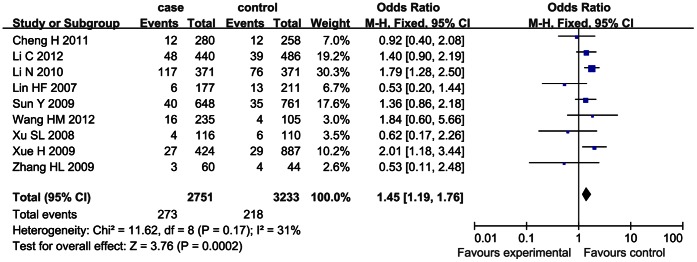
Sensitivity Analysis
The sensitivity analysis was performed with 7 case-control studies whose genotype frequencies in the control group were consistent with Hardy-Weinberg equilibrium (HWE). [14]–[19], [21] The heterogeneity between studies was not significant (I 2<0.5) and the fixed effect model was used for calculating the pooled OR. The sensitivity analysis demonstrated that the significant positive association between SNP 83 and ischemic stroke was found under the dominant model (OR = 1.35, 95% CI: 1.20–1.51, p<0.00001) and recessive model (OR = 1.54, 95% CI: 1.26–1.88, p<0.0001), as shown in Figure 4 and 5.
Figure 4. Sensitivity analysis on the association between SNP 83 and ischemic stroke under the dominant model(CC+CT/TT).

Figure 5. Sensitivity analysis on the association between SNP 83 and ischemic stroke under the recessive model (CC/CT+TT).

Subgroup Meta-analysis
Subgroup analysis was performed for SNP 83 in PDE4D gene and ischemic stroke in Chinese population by the subtypes of ischemic stroke. 5 studies were selected in the subgroup of large-artery atherosclerosis (LAA) [14]–[15], [19]–[21], 6 studies in the subgroup of small-vessel occlusion (SVO) [14], [16], [18]–[21]. The association between SNP 83 and ischemic stroke was significant in LAA subgroup under the dominant model (OR = 1.69, 95% CI: 1.41–2.01, p<0.00001) and recessive model (OR = 1.47, 95% CI: 1.04–2.06, p = 0.03). The remaining pooled OR from SVO subgroup was not significant under the dominant or recessive model (p>0.05), as shown in Figure 6 and 7.
Figure 6. Subgroup analysis on the association between SNP 83 and ischemic stroke under the dominant model (CC+CT/TT).
Figure 7. Subgroup analysis on the association between SNP 83 and ischemic stroke under the recessive model (CC/CT+TT).
Publication Bias
For SNP 83,the distribution of the ORs from individual studies in relation to their respective standard deviation in funnel plot, as shown in Figure 8, failed to detect significant bias under the dominant model, but not recessive model. By using Begg’s test, there was no statistical evidence of publication bias among studies (p = 0.602 for dominant model and p = 0.076 for recessive model, respectively). In Egger’s regression test, there was no statistical evidence of publication bias under the dominant model, but not for the recessive model (p = 0.754 for dominant model and p = 0.026 for recessive model, respectively).
Figure 8. Funnel plot for studies investigating the effect of SNP 83 on the risk of ischemic stroke under the dominant (pane A) and recessive (pane B) models.
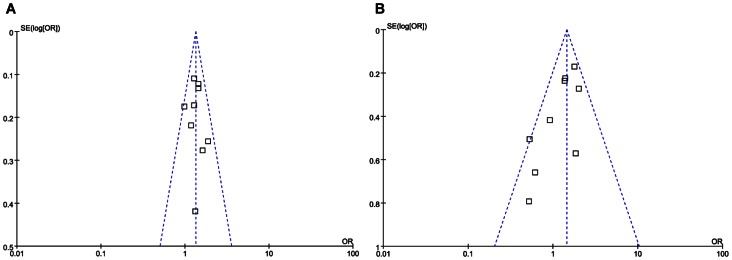
Discussion
Case-control studies are commonly used to find the association between the candidate genes and the complex human diseases. However, the data from the genetic association studies indicates that susceptibility loci for common disease have a small effect. This means that genetic association studies need to test many cases and controls to have a reasonable chance of finding an effect. [23] By increasing the sample size, the meta-analysis has the potential to detect small effects in human genetic association studies. Therefore, we have conducted this meta-analysis in order to derive a more convinced result between SNP 83 in PDE4D gene and susceptibility to ischemic stroke in Chinese population.
Our meta-analysis showed that the risk of developing ischemic stroke in carriers with C allele on SNP 83 was 1.34-fold higher than individuals without C allele in Chinese population. Also, the risk in individuals with CC genotype was 1.45-fold higher than individuals without CC genotype. In case-control studies, a control group that is representative of the general population is expected to be in HWE for the studied locus. Therefore, we selected the case-control studies whose genotype frequencies in the control group were consistent with HWE for sensitivity analysis. The results of sensitivity analysis were close to the results of the meta-analysis before the sensitivity analysis. So it suggests that the combined results of our meta-analysis are reliable.
In 2008, Bevan et al. [24] performed a similar meta-analysis of 9 studies. They did not find any association between SNP 83 and ischemic stroke under the dominant model (OR = 0.96, 95% CI: 0.87–1.07) or recessive model (OR = 0.97, 95% CI: 0.85–1.10). In Bevan’s meta-analysis, the majority of subjects in studies were white, while the population of the studies in our meta-analysis was restricted to Chinese population. The population difference of two meta-analyses may help to explain the difference of Bevan’s results and ours. In 2010, Xu et al. [25] conducted another similar meta-analysis of 7 studies on Asian populations, subjects in 3 of which were Chinese population. The association between PDE4D and ischemic stroke was confirmed for allele C homozygote of SNP 83 (OR = 1.42, 95% CI: 1.14–1.77) but not in the carriers (OR = 1.20, 95% CI: 0.97–1.47). The risk of ischemic stroke in individuals with CC genotype in our meta-analysis was similar to the risk in Xu’s study of Asian populations. Notably, as for carriers with C allele on SNP 83, we also found a significant association with ischemic stroke which was different from Xu’s result.
How can we explain the association between SNP 83 in PDE4D gene and ischemic stroke in Chinese population? 1) PDE4D selectively degrades the second messenger cyclic adenosine monophosphate (cAMP) in vascular smooth muscle cells and activated macrophages, which is a key signaling molecule mediating cell proliferation and migration related to atherosclerosis and plaque stability. [26]–[29] 2) cAMP has been reported to be responsible for neuron survival and a selective inhibitor of cAMP-specific phosphodiesterase type 4 (PDE4) can promote the survival of newborn hippocampal neurons after ischemia.[30]–[32] 3) SNP 83, which is located at the 5′ end of PDE4D, may affect the transcription, splicing, message stability, or message transport of one or more isoforms. [7].
According to TOAST classification, ischemic stroke can be divided into five subtypes: 1) LAA, 2) SVO, 3) cardioembolism (CE), 4) stroke of other determined etiology, and 5) stroke of undetermined etiology. [33] In Chinese population, five studies explored the association between SNP 83 and LAA, and six explored the association between SNP 83 and SVO. Hence, the meta-analysis was conducted in these two subgroups. However, we found the significant association of SNP 83 with ischemic stroke only in LAA subgroup. That can be explained by the role of PDE4D gene in the process of atherosclerosis, as mentioned above. As for the other three subtypes of ischemic stroke, insufficient data were available for conducting subgroup meta-analysis.
The present meta-analysis should be interpreted within the context of its limitations. 1) All included studies of our meta-analysis have followed a retrospective case-control design. It may be more subject to bias and artifact than prospective studies. 2) If another variant in or near the SNP 83 in PDE4D gene was the causal variant, the true association could easily be missed. Different linkage disequilibrium patterns with the causal variant may lead to variable results in different populations. 3) We only focused on SNP 83 in PDE4D gene, while did not evaluate other genes or environmental factors. It is possible that the potential roles of SNP 83 in PDE4D gene are diluted or masked by other gene-gene or gene-environment interactions. 4) Publication bias refers to the decreased likelihood of studies’ results being published when they are near the null, not statistically significant. Publication bias is one of the most important sources of bias in meta-analysis, which can cause the false positive results. In our meta-analysis, under the dominant model, we found no evidence of publication bias by the visual inspection of funnel plot, Begg’s test or Egger’s regression test. However, under the recessive model, we found publication bias by the visual inspection of funnel plot and Egger’s regression test. Hence, the caution is indicated when interpreting the association of SNP 83 with ischemic stroke under the recessive model.
In conclusion, our meta-analysis suggests that SNP 83 in PDE4D gene is associated with developing ischemic stroke in Chinese population. Given the limitations in the present meta-analysis, the results need to be interpreted with caution. Well-designed case-control studies with large sample sizes regarding the association of SNP 83 in PDE4D gene and ischemic stroke need to be performed on different ethnic population in the future.
Supporting Information
PRISMA 2009 Checklist.
(DOC)
Funding Statement
This study was supported by the National Natural Science Foundation of China (Grant Number: 30971018). The funders had no role in study design, data collection and analysis, decision to publish, or preparation of the manuscript.
References
- 1. Donnan GA, Fisher M, Macleod M, Davis SM (2008) Stroke. Lancet 371: 1612–1623. [DOI] [PubMed] [Google Scholar]
- 2. Liu L, Wang D, Wong KS, Wang Y (2011) Stroke and stroke care in China: huge burden, significant workload, and a national priority. Stroke 42: 3651–3654. [DOI] [PubMed] [Google Scholar]
- 3. Thrift AG, Dewey HM, Macdonell RA, McNeil JJ, Donnan GA (2001) Incidence of the major stroke subtypes: initial findings from the North East Melbourne stroke incidence study (NEMESIS). Stroke 32: 1732–1738. [DOI] [PubMed] [Google Scholar]
- 4. Meschia JF, Worrall BB, Rich SS (2011) Genetic susceptibility to ischemic stroke. Nat Rev Neurol 7: 369–378. [DOI] [PMC free article] [PubMed] [Google Scholar]
- 5. Flossmann E, Schulz UG, Rothwell PM (2004) Systematic review of methods and results of studies of the genetic epidemiology of ischemic stroke. Stroke 35: 212–227. [DOI] [PubMed] [Google Scholar]
- 6. Munshi A, Kaul S (2008) Stroke genetics–focus on PDE4D gene. Int J Stroke 3: 188–192. [DOI] [PubMed] [Google Scholar]
- 7. Gretarsdottir S, Thorleifsson G, Reynisdottir ST, Manolescu A, Jonsdottir S, et al. (2003) The gene encoding phosphodiesterase 4D confers risk of ischemic stroke. Nat Genet 35: 131–138. [DOI] [PubMed] [Google Scholar]
- 8. Munshi A, Babu MS, Kaul S, Shafi G, Anila AN, et al. (2009) Phosphodiesterase 4D (PDE4D) gene variants and the risk of ischemic stroke in a South Indian population. J Neurol Sci 285: 142–145. [DOI] [PubMed] [Google Scholar]
- 9. Saleheen D, Bukhari S, Haider SR, Nazir A, Khanum S, et al. (2005) Association of phosphodiesterase 4D gene with ischemic stroke in a Pakistani population. Stroke 36: 2275–2277. [DOI] [PubMed] [Google Scholar]
- 10. Staton JM, Sayer MS, Hankey GJ, Attia J, Thakkinstian A, et al. (2006) Association between phosphodiesterase 4D gene and ischaemic stroke. J Neurol Neurosurg Psychiatry 77: 1067–1069. [DOI] [PMC free article] [PubMed] [Google Scholar]
- 11. Quarta G, Stanzione R, Evangelista A, Zanda B, Di Angelantonio E, et al. (2009) Phosphodiesterase 4D and 5-lipoxygenase activating protein genes and risk of ischemic stroke in Sardinians. Eur J Hum Genet 17: 1448–1453. [DOI] [PMC free article] [PubMed] [Google Scholar]
- 12. Kuhlenbaumer G, Berger K, Huge A, Lange E, Kessler C, et al. (2006) Evaluation of single nucleotide polymorphisms in the phosphodiesterase 4D gene (PDE4D) and their association with ischaemic stroke in a large German cohort. J Neurol Neurosurg Psychiatry 77: 521–524. [DOI] [PMC free article] [PubMed] [Google Scholar]
- 13. Matsushita T, Kubo M, Yonemoto K, Ninomiya T, Ashikawa K, et al. (2009) Lack of association between variations of PDE4D and ischemic stroke in the Japanese population. Stroke 40: 1245–1251. [DOI] [PubMed] [Google Scholar]
- 14.Li C, Song B, Sun L, Zhou C, Wang HP, et al.. (2012) Association of polymorphism of phosphodiesterase 4D gene with ischemic stroke. Acta Academiae Medicinae Qindao Universitatis 48: 298–300, 304.
- 15. Wang HM, Chen XL, Ye HH, Bi Y, Pan DB, et al. (2012) Association of phosphodiesterase 4D gene with atherothrombosis ischemic stroke. J Med Res 41: 134–137. [Google Scholar]
- 16. Cheng H, Jin QW, Li LX, Ding XS, Song XJ, et al. (2011) Association of ALOX5AP and PDE4D with the risk of lacunar infarct in people from Jiangsu Province, China. Neural Regeneration Research 6: 935–940. [Google Scholar]
- 17. Li N, He Z, Xu J, Liu F, Deng S, et al. (2010) Association of PDE4D and IL-1 gene polymorphism with ischemic stroke in a Han Chinese population. Brain Res Bull 81: 38–42. [DOI] [PubMed] [Google Scholar]
- 18. Sun Y, Huang Y, Chen X, Liu Y, Lu X, et al. (2009) Association between the PDE4D gene and ischaemic stroke in the Chinese Han population. Clin Sci (Lond) 117: 265–272. [DOI] [PubMed] [Google Scholar]
- 19. Xue H, Wang H, Song X, Li W, Sun K, et al. (2009) Phosphodiesterase 4D gene polymorphism is associated with ischaemic and haemorrhagic stroke. Clin Sci (Lond) 116: 335–340. [DOI] [PubMed] [Google Scholar]
- 20. Zhang HL, Wang SR, Li SM (2009) Study on association of the single nucleotide polymorphism of phosphodiesterase 4D with stroke J Chin Microcirc. 13: 624–627. [Google Scholar]
- 21. Xu SL, Zhang YD, Lin XJ (2008) Relationship between phosphodiesterase 4D gene polymorphism and ischemic cerebral vascular disease. J Clin Neurol 21: 249–252. [Google Scholar]
- 22. Lin HF, Liao YC, Liou CW, Liu CK, Juo SH (2007) The phosphodiesterase 4D gene for early onset ischemic stroke among normotensive patients. J Thromb Haemost 5: 436–438. [DOI] [PubMed] [Google Scholar]
- 23. Munafo MR, Flint J (2004) Meta-analysis of genetic association studies. Trends Genet 20: 439–444. [DOI] [PubMed] [Google Scholar]
- 24. Bevan S, Dichgans M, Gschwendtner A, Kuhlenbaumer G, Ringelstein EB, et al. (2008) Variation in the PDE4D gene and ischemic stroke risk: a systematic review and meta-analysis on 5200 cases and 6600 controls. Stroke 39: 1966–1971. [DOI] [PubMed] [Google Scholar]
- 25. Xu X, Li X, Li J, Ou R, Sheng W (2010) Meta-analysis of association between variation in the PDE4D gene and ischemic cerebral infarction risk in Asian populations. Neurogenetics 11: 327–333. [DOI] [PubMed] [Google Scholar]
- 26. Nakayama T, Asai S, Sato N, Soma M (2007) PDE4D gene in the STRK1 region on 5q12: susceptibility gene for ischemic stroke. Curr Med Chem 14: 3171–3178. [DOI] [PubMed] [Google Scholar]
- 27. Gulcher JR, Gretarsdottir S, Helgadottir A, Stefansson K (2005) Genes contributing to risk for common forms of stroke. Trends Mol Med 11: 217–224. [DOI] [PubMed] [Google Scholar]
- 28. Libby P (2002) Inflammation in atherosclerosis. Nature 420: 868–874. [DOI] [PubMed] [Google Scholar]
- 29. Naghavi M, Libby P, Falk E, Casscells SW, Litovsky S, et al. (2003) From vulnerable plaque to vulnerable patient: a call for new definitions and risk assessment strategies: Part I. Circulation. 108: 1664–1672. [DOI] [PubMed] [Google Scholar]
- 30. Rydel RE, Greene LA (1988) cAMP analogs promote survival and neurite outgrowth in cultures of rat sympathetic and sensory neurons independently of nerve growth factor. Proc Natl Acad Sci U S A 85: 1257–1261. [DOI] [PMC free article] [PubMed] [Google Scholar]
- 31. Hanson MG Jr, Shen S, Wiemelt AP, McMorris FA, Barres BA (1998) Cyclic AMP elevation is sufficient to promote the survival of spinal motor neurons in vitro. J Neurosci 18: 7361–7371. [DOI] [PMC free article] [PubMed] [Google Scholar]
- 32. Sasaki T, Kitagawa K, Omura-Matsuoka E, Todo K, Terasaki Y, et al. (2007) The phosphodiesterase inhibitor rolipram promotes survival of newborn hippocampal neurons after ischemia. Stroke 38: 1597–1605. [DOI] [PubMed] [Google Scholar]
- 33. Adams HP Jr, Bendixen BH, Kappelle LJ, Biller J, Love BB, et al. (1993) Classification of subtype of acute ischemic stroke. Definitions for use in a multicenter clinical trial. TOAST. Trial of Org 10172 in Acute Stroke Treatment. Stroke 24: 35–41. [DOI] [PubMed] [Google Scholar]
Associated Data
This section collects any data citations, data availability statements, or supplementary materials included in this article.
Supplementary Materials
PRISMA 2009 Checklist.
(DOC)



